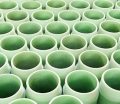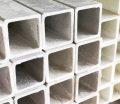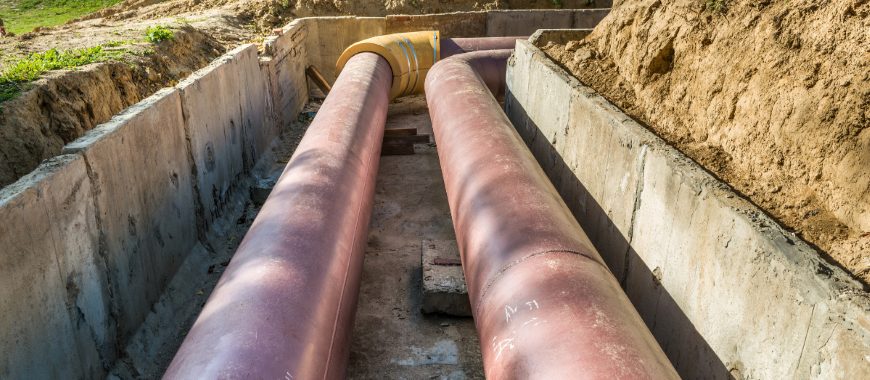
Large diameter fiberglass pipe is a critical component in modern infrastructure, known for its durability, corrosion resistance, and versatility. FRP (Fiberglass Reinforced Plastic) pipe technology has advanced significantly, offering solutions that meet the demanding needs of industries such as power generation, water supply, and wastewater management. The large diameter fiberglass pipe is especially important in applications where traditional materials like steel or concrete may not perform as well, providing an efficient and long-lasting alternative. Its use in large-scale projects underscores its importance, delivering reliable performance while reducing maintenance costs and ensuring sustainability in infrastructure development. Large diameter fiberglass pipe (4″-156″), 450 psi rating, for corrosive/vacuum to high-pressure applications, above/below ground.
What is Large Diameter Fiberglass Pipe
Large diameter fiberglass pipe is an essential innovation in the field of infrastructure, offering a versatile, durable, and cost-effective solution for various industrial applications. As the demand for more resilient and sustainable piping solutions increases, large diameter fiberglass pipes have emerged as a preferred choice due to their unique properties and advantages over traditional materials such as steel and concrete. The technology behind FRP (Fiberglass Reinforced Plastic) pipes has evolved significantly, allowing for the production of pipes that not only meet but exceed the requirements of modern infrastructure projects. These pipes are extensively used in industries such as power generation, water supply, and wastewater management, where the performance and longevity of the piping system are crucial.
The large diameter fiberglass pipe is particularly beneficial in applications requiring pipes with diameters exceeding 1000mm, where the material’s inherent corrosion resistance, strength-to-weight ratio, and smooth inner surface offer significant advantages. These pipes are designed to withstand the harsh conditions of industrial environments, providing a reliable and long-lasting alternative to traditional materials. The importance of large diameter fiberglass pipes in modern infrastructure cannot be overstated, as they play a critical role in ensuring the efficiency, safety, and sustainability of large-scale projects.
Advantages of Large Diameter Fiberglass Pipe
Large diameter fiberglass pipes are increasingly popular due to their cost-effectiveness, long service life, and minimal maintenance needs. Unlike steel, which is prone to corrosion and requires frequent repairs, the fiberglass properties offer significant long-term savings. Their lightweight nature also reduces installation costs and project timelines, while their flexibility allows for use in various applications, including underground and above-ground systems. Environmentally, fiberglass pipes are non-toxic, sustainable, and have a longer lifespan, reducing the need for replacements and minimizing environmental impact. Additionally, they are designed to withstand extreme conditions, ensuring reliable performance in demanding industries like petrochemicals.
Long Life and Durability
Large diameter fiberglass pipes are designed for a long, maintenance-free service life. The inherent corrosion resistance of fiberglass ensures that these pipes can withstand harsh environments without degrading. Whether used in corrosive chemical processes, wastewater systems, or high-pressure applications, fiberglass pipes continue to perform reliably over time. Their superior resistance to environmental factors such as chemicals, moisture, and biological growth significantly reduces the need for frequent repairs and replacements, providing a cost-effective and durable solution.
Easy Installation
Fiberglass pipes are lightweight, making them easier to handle, transport, and install compared to traditional materials like steel or concrete. Their high stiffness design ensures predictable and reliable performance, and they can be installed using methods commonly specified for traditional pipes. Push-together joints make the assembly process quick and simple, reducing labor costs and installation time. Additionally, fiberglass pipes can be installed in challenging or remote locations, where heavier materials might be difficult to manage, further enhancing their versatility and ease of use.
Fits Standard Pipe Accessories
Fiberglass pipes are designed to match the outer diameter (O.D.) of ductile iron pipes, up to 48” in diameter, ensuring compatibility with standard pipe accessories such as saddles, taps, fittings, couplings, and clamps. This compatibility makes it easy to integrate fiberglass pipes into existing infrastructure, reducing the need for specialized components or custom solutions. As a result, the installation process is streamlined and efficient, with readily available accessories that help maintain system integrity.
Leak-Free Joints
Fiberglass pipes feature rubber-ring-sealed bell-spigot and coupling joints, ensuring fast, foolproof assembly and long-term leak-free service. These joints provide a secure connection that prevents leaks, even in high-pressure environments. The reliable sealing ensures that the system operates without interruptions, maintaining optimal performance and safety over the life of the pipeline.
High Flow Capacity
The oversized internal diameters and smooth, glass-like interior surface of large diameter fiberglass pipes contribute to their high flow capacity. These pipes offer significant advantages in systems where fluid transport is critical. The smooth surface reduces friction and fluid flow resistance, allowing for higher flow rates and reduced energy consumption in pumped systems. This can lead to power savings, particularly in large-scale water distribution or industrial systems where efficient fluid transport is essential.
Consistent Quality
The production of large diameter fiberglass pipes is controlled by advanced computer systems, ensuring consistent quality and high-performance standards. Each pipe is manufactured according to ASTM and AWWA standards, ensuring it meets the rigorous requirements of various applications. This consistent quality provides assurance that the pipes will perform reliably in demanding conditions, reducing the risk of failures or downtime in critical systems.
Lightweight and Easy to Handle
Fiberglass pipes are considerably lighter than traditional pipe materials, such as steel or concrete, making them easier to handle and install. This reduction in weight helps to lower transportation costs and simplifies the installation process, especially in challenging or remote areas. Their lightweight nature also reduces the need for heavy lifting equipment, making the installation process faster and more efficient.
Excellent Chemical Resistance
Large diameter fiberglass pipes are highly resistant to a wide range of chemicals, including acids, solvents, and other corrosive substances. This makes them ideal for use in chemical processing plants, industrial effluent systems, and other applications where exposure to harsh chemicals is a concern. The chemical resistance of fiberglass pipes ensures they maintain their structural integrity and performance over time, even in aggressive environments.
Low Fluid Flow Resistance
Due to the smooth internal surface of fiberglass pipes, fluid flow resistance is significantly reduced compared to traditional pipe materials. This smooth surface reduces energy loss during fluid transport, improving the overall efficiency of the system. This characteristic is particularly beneficial in systems where large volumes of water or other fluids need to be moved quickly and efficiently.
Design and Customization Flexibility
Another significant advantage of large diameter fiberglass pipe is the flexibility in design and customization it offers. At GangLong Fiberglass, we provide a range of large diameter fiberglass pipes tailored to meet specific project requirements. The ability to customize pipe dimensions, wall thickness, and other specifications ensures that the pipes are perfectly suited to their intended application, whether it’s for transporting water in a municipal system or carrying chemicals in an industrial plant.
The manufacturing process for large diameter fiberglass pipes also allows for the integration of various features, such as UV resistance, fire retardancy, and enhanced mechanical properties, depending on the application’s needs. This customization capability is particularly important in industries where the piping system must adhere to strict safety and performance standards.
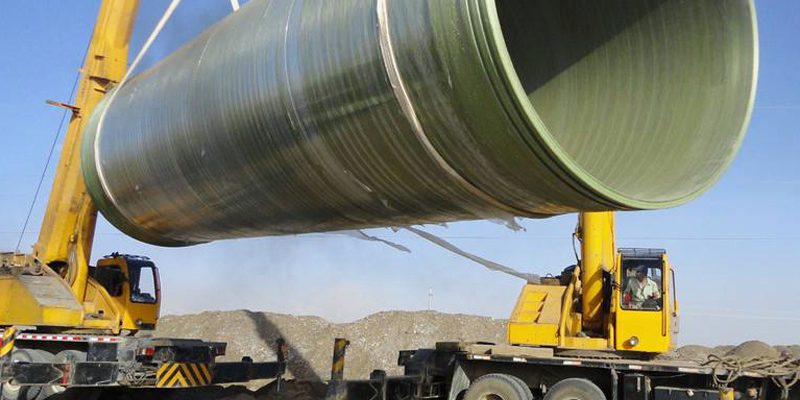
Applications of Large Diameter Fiberglass Pipe
Large diameter fiberglass pipes are widely used across various industries due to their corrosion resistance, high-pressure endurance, and efficient flow characteristics. In power generation, they are essential for cooling water systems, where they maintain efficient flow rates and withstand harsh conditions. In water supply and wastewater management, these pipes transport potable water, sewage, and industrial effluents, benefiting from their resistance to chemicals and biological growth. Their lightweight design also makes them ideal for installation in remote locations. Additionally, in the oil and gas industry, large diameter fiberglass pipes, similar to high pressure fiberglass pipe, are used to transport crude oil, natural gas, and hydrocarbons under extreme conditions, showcasing their durability and versatility in high-demand, high-pressure applications.
Water Supply and Distribution
Large diameter fiberglass pipes are commonly used for water supply systems, including raw water supply lines for potable water projects. Their corrosion resistance makes them suitable for transporting fresh water over long distances without the risk of degradation commonly associated with traditional materials. Additionally, fiberglass pipes are widely used in force mains and outfalls, ensuring reliable water delivery and efficient wastewater disposal.
Sewer and Wastewater Systems
In sewer interceptor systems, sanitary sewer projects, and pressure sewer systems, large diameter fiberglass pipes offer an efficient solution for transporting wastewater and sewage. The pipes’ resistance to corrosion, even in highly acidic or alkaline environments, makes them ideal for wastewater treatment plant (WWTP) piping, odor control piping, and other related infrastructure. They are also extensively used in pipeline rehabilitation projects, such as slip liners, which allow for the renewal of aging sewer lines without the need for excavation.
Industrial Applications
Large diameter fiberglass pipes are essential in various industrial effluent systems, where they safely transport chemical waste, oils, and gases. These pipes are commonly used in chemical process lines, industrial effluent lines, and saltwater lines. Their durability in harsh chemical environments ensures the safe transport of substances like acids, solvents, and hazardous liquids, making them invaluable in industries like chemical processing and oil refining.
Irrigation and Agricultural Systems
Fiberglass pipes are an excellent choice for irrigation systems in agriculture. Their lightweight nature and resistance to corrosion allow them to efficiently deliver water across large agricultural areas, ensuring that crops receive the necessary water supply. The pipes’ strength and reliability also make them suitable for use in feed lines for agricultural applications, including penstocks for hydroelectric power plants and irrigation lines for large-scale agricultural projects.
Energy and Power Generation
In hydroelectric power plants, large diameter fiberglass pipes are used for feed lines and penstocks, enabling the efficient movement of water through turbines to generate power. They are also widely used in cooling water systems in power plants, where they ensure effective circulation of water for cooling purposes. Their ability to withstand extreme conditions, including high-pressure and high-temperature environments, makes them ideal for critical energy infrastructure.
Geothermal and Oil & Gas Applications
Large diameter fiberglass pipes are utilized in geothermal systems for energy extraction, where they are used to transport hot water and steam. These pipes are also used in production tubing systems for ESP (electric submersible pump), gas lift, rod pumping, and progressive cavity pump (PCP) applications in the oil and gas industry. Their corrosion-resistant nature and ability to handle high-pressure conditions make them ideal for applications in oil wells, gas fields, and other energy extraction processes.
Well Casing and Drilling Operations
Fiberglass pipes are used extensively in well casing applications, including observation well casings, open hole casings, and casing liners. These pipes are crucial for maintaining the structural integrity of wells and ensuring that fluids are transported safely and efficiently during drilling operations. They are also used in cement tail pipe systems, which are necessary for sealing wells and preventing fluid migration between layers of rock.
Stormwater and Drainage Systems
Large diameter fiberglass pipes are used in stormwater management systems, where they help collect and transport runoff water efficiently. Their durability and resistance to weathering make them ideal for stormwater pipelines and drainage systems in urban environments, where they must withstand heavy rainfall and harsh conditions.
Design Considerations for Large Diameter Fiberglass Pipe
When designing and implementing large diameter fiberglass pipe systems, several critical factors must be taken into account to ensure their effective performance and longevity. These considerations include the impact of local soil conditions, the appropriate burial depth, the load-bearing capacity, pressure tolerance, thermal expansion, and the operating temperature range. Each of these aspects plays a vital role in determining how well large diameter fiberglass pipe can function in various applications, particularly in infrastructure projects where reliability and durability are paramount.
Impact of Local Soil Conditions and Burial Depth
The soil type significantly impacts the installation and stability of large diameter fiberglass pipes. High clay content can exert pressure, causing deformation, while sandy soil may require extra support to prevent shifting. Burial depth is crucial for protection from surface loads and future maintenance access. It must be carefully calculated to comply with local standards and ensure long-term system reliability.
Load-Bearing Capacity and Pressure Tolerance
Large diameter fiberglass pipes need to withstand internal pressure and external loads such as soil weight and traffic. Proper load-bearing capacity ensures safe operation. The pipe’s pressure tolerance, determined by wall thickness and material composition, must be considered, especially for high-pressure fluid or gas transport, ensuring the system’s reliability under varying operational conditions.
Thermal Expansion and Operating Temperature Range
Fiberglass pipes expand and contract with temperature changes, potentially causing stress at joints if not managed. Expansion joints or flexible couplings are used to absorb this thermal movement. The selection of pipe materials must consider the operating temperature range, ensuring the system remains stable and functional even under extreme temperature variations encountered in industries like power generation and chemical processing.
Customization and Adaptability
Large diameter fiberglass pipes offer extensive customization, including diameter, wall thickness, and specialized fittings. This adaptability makes them suitable for various applications, with the ability to meet specific project needs. Their lightweight design also makes installation easier, particularly in challenging environments, and their flexibility allows them to adapt to shifts in the ground without compromising integrity.
Environmental Impact and Sustainability
Fiberglass pipes are resistant to corrosion and chemical degradation, reducing the need for repairs and replacements, thereby extending their lifespan. Manufactured with environmentally friendly processes, they contribute to sustainability by minimizing environmental impact and promoting the use of recyclable materials. This makes fiberglass pipes an eco-friendly option for infrastructure projects focused on longevity and sustainability.
Cost-Effectiveness in Long-Term Use
While large diameter fiberglass pipes may have a higher initial cost, their long-term durability and low maintenance costs make them a cost-effective option. Their resistance to corrosion reduces the need for frequent repairs, and their easy installation cuts labor costs. Over time, these factors lead to substantial savings, making fiberglass pipes a more economical choice compared to traditional materials.
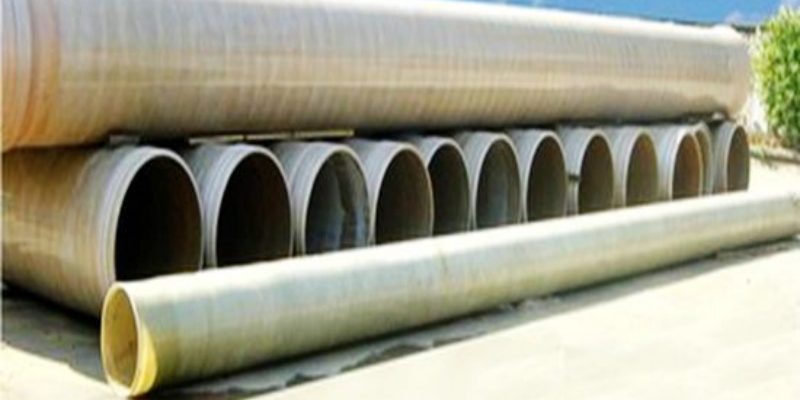
Fiber Glass Duct Board: Enhancing Energy Efficiency in Buildings
Manufacturing Processes of Large Diameter Fiberglass Pipe
The manufacturing processes of large diameter fiberglass pipe are critical in ensuring the strength, durability, and performance of the final product. These processes involve advanced techniques that have been refined over the years to meet the stringent demands of modern infrastructure projects. At GangLong Fiberglass, we utilize state-of-the-art manufacturing methods to produce large diameter fiberglass pipes that exceed industry standards, offering a reliable solution for a wide range of applications.
Filament Winding Process for Enhanced Strength
One of the most common manufacturing methods for large diameter fiberglass pipe is the filament winding process. This process involves winding continuous strands of fiberglass filaments around a mandrel, which is a cylindrical core that defines the pipe’s shape and size. The filaments are impregnated with a resin, typically an epoxy or polyester, which serves as the binding agent and enhances the structural integrity of the pipe.
During the filament winding process, the tension on the filaments is carefully controlled to ensure even distribution and alignment. This meticulous control is crucial because it directly impacts the strength and stiffness of the pipe. The filament winding process allows for the creation of pipes with a high strength-to-weight ratio, making them ideal for applications where both durability and weight are critical factors.
At GangLong Fiberglass, the filament winding process is optimized to produce large diameter fiberglass pipes that can withstand extreme pressure and environmental conditions. This method is particularly advantageous for producing pipes with larger diameters, as it ensures consistent quality and structural integrity throughout the length of the pipe. The result is a strong, lightweight pipe that offers excellent resistance to corrosion, making it suitable for use in industries such as oil and gas, chemical processing, and water treatment.
Contact Molding Process for Custom Applications
While the filament winding process is ideal for large-scale production of uniform pipes, the contact molding process offers greater flexibility for custom applications. This process, also known as fiberglass hand lay-up, involves manually layering fiberglass mats or fabrics onto a mold, followed by the application of resin. The layers are then compressed and allowed to cure, forming a solid, reinforced structure.
The contact molding process is highly versatile and can be used to create complex shapes and custom pipe configurations that are not feasible with automated processes. This makes it an excellent choice for producing large diameter fiberglass pipes for specialized applications where unique dimensions or specific performance characteristics are required.
At GangLong Fiberglass, we utilize the contact molding process to manufacture custom large diameter fiberglass pipes that meet the specific needs of our clients. This process allows us to produce pipes with varying wall thicknesses, diameters, and lengths, ensuring that each product is tailored to its intended use. Additionally, the contact molding process enables the integration of additional features such as UV resistance, fire retardancy, and enhanced mechanical properties, further expanding the range of applications for large diameter fiberglass pipes.
Quality Control Measures and Industry Standards
Ensuring the quality and performance of large diameter fiberglass pipe is paramount, especially given the critical applications in which these pipes are used. At GangLong Fiberglass, we adhere to stringent quality control measures throughout the manufacturing process to guarantee that our products meet the highest industry standards.
Quality control begins with the selection of raw materials, including high-quality fiberglass filaments and resins. Each batch of materials undergoes rigorous testing to ensure that it meets our specifications for strength, durability, and chemical resistance. During the manufacturing process, we implement continuous monitoring and inspection at each stage, from filament winding or contact molding to curing and finishing.
In addition to internal quality control procedures, our large diameter fiberglass pipes are manufactured in compliance with recognized industry standards. These standards include ASTM D2310 for classification of fiberglass pipe, ASTM D2996 for filament wound fiberglass tube, and AWWA C950 for fiberglass pressure pipe. Adherence to these standards ensures that our pipes are suitable for use in demanding environments and can withstand the rigors of their intended applications.
To further ensure the reliability of our large diameter fiberglass pipes, we conduct a series of tests on the finished products. These tests may include hydrostatic pressure testing, tensile strength testing, and dimensional inspections. By subjecting our pipes to these rigorous evaluations, we can confidently offer products that meet or exceed the performance requirements of our customers.
Environmental Considerations in Manufacturing
The manufacturing processes for large diameter fiberglass pipe also take into account environmental considerations. At GangLong Fiberglass, we are committed to sustainability and minimizing the environmental impact of our production activities. The filament winding and contact molding processes both involve the use of resins and other materials that can be managed to reduce waste and emissions.
For example, the resins used in the production of large diameter fiberglass pipes are selected not only for their performance characteristics but also for their environmental impact. Low-VOC (volatile organic compound) resins are used to minimize emissions during the curing process, contributing to cleaner air and a safer work environment.
Additionally, the efficiency of the manufacturing processes at GangLong Fiberglass means that waste materials are minimized. Any excess resin or fiberglass can often be recycled or repurposed, further reducing the environmental footprint of our operations. The durability and long service life of large diameter fiberglass pipes also contribute to their sustainability, as they require less frequent replacement and maintenance compared to traditional materials like steel or concrete.
Innovation and Continuous Improvement
At GangLong Fiberglass, we believe that innovation and continuous improvement are key to maintaining our position as a leader in the manufacturing of large diameter fiberglass pipe. We are constantly exploring new materials, processes, and technologies to enhance the performance and versatility of our products.
One area of ongoing research is the development of advanced resin systems that offer even greater resistance to corrosion, heat, and chemical exposure. These resins, combined with the latest filament winding and contact molding techniques, have the potential to produce pipes with unprecedented durability and reliability.
We are also investing in automation and digital technologies to improve the precision and efficiency of our manufacturing processes. By integrating advanced sensors and control systems into our production lines of fiberglass tubes, we can achieve tighter tolerances and more consistent quality across all of our fiberglass tubes large diameter.
Finally, we are committed to providing our customers with the best possible service and support. This includes offering custom design and engineering services, as well as comprehensive technical assistance to ensure that our large diameter fiberglass pipes meet the specific needs of each project. Our team of experts is always available to answer questions, provide guidance, and help our customers achieve their goals.
Top Benefits of a Carbon Fiber Pipeliner Welding Hood
Installation Methods for Large Diameter Fiberglass Pipes
Large diameter fiberglass pipes are increasingly utilized across various industries due to their durability, corrosion resistance, and ease of installation. When considering the installation of these pipes, several techniques can be employed, depending on the project’s needs, the environment, and available resources. Below are the most common installation methods for large diameter fiberglass pipes:
Direct Bury
Direct burying is one of the simplest and most widely used methods for installing large diameter fiberglass pipes, especially in trenchless construction. This method involves placing the pipe directly into an excavated trench in the ground. The fiberglass pipes are designed to withstand the pressures of being buried underground, including soil load and environmental factors like water saturation. This installation method is often used for wastewater, drainage, and water supply lines.
Sliplining
Sliplining is a trenchless pipe rehabilitation technique often used when replacing old, damaged pipes. In this method, a new, smaller diameter fiberglass pipe is inserted inside an existing pipe. The new pipe is then pushed through the old pipe, effectively reusing the original structure and minimizing the need for extensive excavation. Sliplining is ideal for urban areas where digging up the ground would cause significant disruption.
Jacking & Microtunneling
Jacking and microtunneling methods are used for the installation of large diameter pipes in areas where trenchless methods are required due to challenging ground conditions or environmental concerns. In jacking, pipes are pushed through the soil using hydraulic pressure, while microtunneling uses a small, remotely controlled tunnel boring machine to create a path for the pipe. Both methods are suitable for installing large diameter fiberglass pipes under roads, rivers, or other structures without disturbing the surface.
Tunneling (Two Pass)
Tunneling involves digging a large tunnel in the ground to allow for the installation of large diameter pipes. The “two-pass” method refers to the process of initially drilling a pilot tunnel, followed by reaming it out to the desired size. This method is most commonly used when the pipeline needs to be installed in deep or hard-to-reach areas. Fiberglass pipes are often chosen for tunneling projects due to their lightweight nature and resistance to corrosion, which makes them ideal for underground installations.
Aboveground
In aboveground installations, large diameter fiberglass pipes are installed on supports or racks above the ground. This method is ideal for applications where digging is impractical or unnecessary, such as in industrial settings, where pipes need to be elevated for safety or ease of maintenance. Fiberglass pipes are particularly suited for aboveground installations due to their strength and resistance to UV radiation, which can degrade other materials over time.
Pipe Bursting
Pipe bursting is a trenchless technique used for replacing old, worn-out pipes without the need for extensive digging. The process involves using a bursting head to break apart the old pipe while simultaneously pulling a new, larger diameter fiberglass pipe into place. This method is particularly beneficial for upgrading existing infrastructure in populated areas or locations with limited space for excavation.
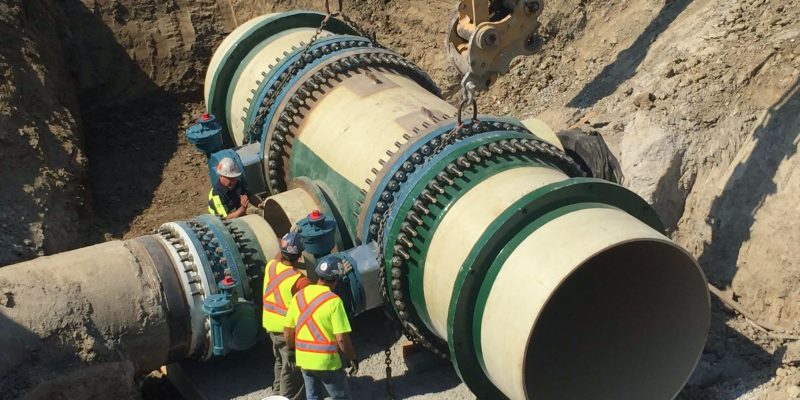
Key Features of Large Diameter Fiberglass Pipe
Large diameter fiberglass pipe is recognized for its unique combination of features that make it an ideal choice for various industrial applications. These pipes are engineered to deliver exceptional performance in demanding environments, offering benefits that traditional materials like steel and concrete cannot match. The key features of large diameter fiberglass pipe include its outstanding corrosion resistance, impressive strength-to-weight ratio, and the smooth inner surface that contributes to improved flow efficiency. Understanding these features is essential for appreciating the advantages that large diameter fiberglass pipe can bring to infrastructure projects across industries.
Corrosion Resistance and Durability
One of the most significant advantages of large diameter fiberglass pipe is its remarkable resistance to corrosion. In environments where traditional materials like steel would quickly succumb to the effects of moisture, chemicals, or saltwater, fiberglass pipes stand out as a superior alternative. This corrosion resistance is due to the inherent properties of the materials used in the manufacturing process. Fiberglass, combined with high-quality resins, creates a non-reactive surface that does not degrade in the presence of corrosive substances.
For instance, in industries such as chemical processing, wastewater treatment, and marine applications, large diameter fiberglass pipe is often the material of choice because of its ability to withstand harsh conditions. The pipe’s durability extends its service life far beyond that of metal alternatives, reducing the need for frequent replacements and minimizing maintenance costs. At GangLong Fiberglass, we ensure that our large diameter fiberglass pipes are manufactured using resins that are specifically formulated to resist the aggressive chemicals and environmental factors encountered in these industries.
The durability of large diameter fiberglass pipe is not limited to its resistance to chemical corrosion. These pipes are also highly resistant to physical wear and tear. Unlike metal pipes, which can suffer from abrasion or mechanical damage over time, fiberglass pipes maintain their integrity even in challenging conditions. This resilience makes large diameter fiberglass pipes particularly suitable for underground installations, where they may be exposed to shifting soil, rocks, and other potentially damaging forces.
Strength-to-Weight Ratio and Mechanical Properties
Another key feature of large diameter fiberglass pipe is its impressive strength-to-weight ratio. Fiberglass pipes are known for being lightweight yet incredibly strong, a combination that offers several practical benefits. The high strength-to-weight ratio of these pipes means that they can withstand high internal pressures and external loads without the need for excessive wall thickness. This is particularly important in applications such as high-pressure water transmission, industrial fluid transport, and structural applications where weight reduction is critical.
The mechanical properties of large diameter fiberglass pipe are carefully engineered during the manufacturing process to ensure optimal performance. At GangLong Fiberglass, we utilize advanced techniques like filament winding and contact molding to produce pipes that meet precise strength specifications. The result is a product that offers consistent mechanical performance, even under extreme conditions.
For example, large diameter fiberglass pipes are often used in the oil and gas industry, where they must endure high pressure, temperature variations, and mechanical stress. The lightweight nature of fiberglass pipes reduces the load on supporting structures, making installation easier and more cost-effective. Additionally, the material’s flexibility allows it to absorb shocks and vibrations without cracking or breaking, further enhancing its durability in demanding environments.
The strength-to-weight ratio of large diameter fiberglass pipe also contributes to its ease of handling and installation. Because these pipes are lighter than their metal counterparts, they can be transported and installed with less effort and lower costs. This is particularly advantageous in remote or difficult-to-access locations, where the logistics of transporting heavy materials can be challenging. The reduced weight of fiberglass pipes also means that less heavy machinery is required for installation, further lowering project costs and reducing the environmental impact.
Smooth Inner Surface for Improved Flow Efficiency
A critical feature of large diameter fiberglass pipe is its smooth inner surface, which plays a vital role in enhancing flow efficiency. The smoothness of the internal surface of fiberglass pipes reduces friction as fluids pass through, allowing for more efficient flow with less resistance. This characteristic is particularly beneficial in applications where maintaining high flow rates is essential, such as in water supply systems, sewage networks, and industrial fluid transport.
The smooth inner surface of large diameter fiberglass pipe also contributes to its resistance to scale and deposit formation. In metal pipes, rough surfaces can lead to the accumulation of mineral deposits, which can decrease the internal diameter of the pipe and reduce flow efficiency over time. This problem is significantly mitigated in fiberglass pipes, where the smooth surface inhibits the buildup of such deposits, ensuring consistent flow rates throughout the pipe’s service life.
At GangLong Fiberglass, we place a strong emphasis on ensuring that our large diameter fiberglass pipes maintain their smooth inner surfaces throughout the manufacturing process. This is achieved through careful control of the resin application and curing stages, which are crucial in preventing surface irregularities that could impact flow efficiency. The result is a pipe that not only performs well in terms of flow but also requires less maintenance, as there is less need for cleaning or chemical treatment to remove deposits.
The improved flow efficiency offered by large diameter fiberglass pipe has direct implications for the overall performance of piping systems. In applications such as municipal water supply, irrigation, and industrial fluid transport, maintaining high flow rates is critical to the system’s efficiency and effectiveness. By minimizing friction losses, large diameter fiberglass pipes help to reduce the energy required to pump fluids through the system, leading to lower operational costs and reduced environmental impact.
Enhanced Thermal and Electrical Insulation Properties
In addition to its corrosion resistance, strength-to-weight ratio, and smooth inner surface, large diameter fiberglass pipe also offers superior thermal and electrical insulation properties. These features are particularly important in applications where the pipe may be exposed to extreme temperatures or where electrical insulation is required to prevent the risk of short circuits or other electrical hazards.
Fiberglass is a poor conductor of heat, which means that large diameter fiberglass pipes can help to maintain the temperature of the fluid being transported. This is especially beneficial in applications where temperature control is critical, such as in the transport of hot or cold fluids in industrial processes or HVAC systems. The thermal insulation properties of fiberglass pipes reduce the need for additional insulation materials, simplifying installation and lowering costs.
Similarly, the electrical insulation properties of large diameter fiberglass pipe make it an excellent choice for use in environments where electrical conductivity must be minimized. This is particularly relevant in industries such as power generation and electrical engineering, where the piping system may be exposed to electrical currents. The non-conductive nature of fiberglass helps to prevent electrical faults and enhances the safety of the system.
At GangLong Fiberglass, we ensure that our large diameter fiberglass pipes are manufactured to provide optimal thermal and electrical insulation, meeting the specific needs of our customers. These properties, combined with the other key features of fiberglass pipes, make them a versatile and reliable choice for a wide range of applications.
Longevity and Environmental Sustainability
The longevity of large diameter fiberglass pipe is another key feature that sets it apart from traditional materials. The combination of corrosion resistance, mechanical strength, and smooth internal surfaces ensures that these pipes have a long service life, often exceeding 50 years in many applications. This extended lifespan translates into lower lifecycle costs, as there is less need for frequent replacements and repairs.
In terms of environmental sustainability, large diameter fiberglass pipe offers several advantages. The production of fiberglass pipes requires less energy compared to the manufacturing of steel or concrete pipes, resulting in lower carbon emissions. Additionally, the lightweight nature of fiberglass reduces the energy required for transportation and installation, further minimizing the environmental impact.
At GangLong Fiberglass, we are committed to producing large diameter fiberglass pipes that not only perform well but also contribute to a more sustainable future. Our manufacturing processes are designed to minimize waste and reduce the use of harmful chemicals, ensuring that our products are environmentally friendly. The long service life of fiberglass pipes also means that fewer resources are needed for maintenance and replacement, reducing the overall environmental footprint of the piping system.
The environmental benefits of large diameter fiberglass pipe are complemented by its recyclability. At the end of its service life, fiberglass pipe can be recycled and repurposed for use in other applications, further extending its usefulness and reducing waste. This recyclability makes fiberglass an attractive option for companies looking to improve their sustainability practices and reduce their impact on the environment.
Key Advantages of Using China FRP Irrigation Pipe in Farming
Large Diameter Fiberglass Pipe: Comprehensive FRP Pipe Fittings
Smooth Sweep Elbows
Smooth sweep elbows are essential components for large diameter fiberglass pipe systems, providing smooth, gradual turns that reduce pressure loss and turbulence. These elbows help maintain a steady flow rate, making them ideal for applications where fluid efficiency is crucial. Their design minimizes friction, preventing wear and extending the lifespan of the system. Smooth sweep elbows are commonly used in large-scale fluid transport systems, especially when large diameter fiberglass pipes are involved, offering a significant advantage in systems requiring continuous, high-volume fluid movement.
Mitered Elbows
Mitered elbows offer flexibility in pipe systems that require precise angular turns. These elbows are custom-made to fit specific angles, especially in confined spaces where smooth sweep elbows cannot be used. Mitered elbows are ideal for systems where space constraints or strict design requirements necessitate sharp bends. Despite their angular design, they maintain a high level of flow efficiency and strength. For large diameter fiberglass pipe systems, mitered elbows provide the necessary adaptability to handle complex piping configurations, offering both durability and reliability.
Concentric and Eccentric Reducers
Concentric and eccentric reducers are used to transition between pipes of different diameters, ensuring a smooth change in flow direction and maintaining pressure levels. Concentric reducers are used when a uniform, symmetrical pipe alignment is needed, while eccentric reducers help align off-center pipes. These reducers prevent turbulence and pressure loss, ensuring that the fluid flow remains constant and efficient. For large diameter fiberglass pipe systems, concentric and eccentric reducers are crucial in maintaining optimal system performance, particularly when pipes of varying sizes need to be integrated into the system.
Tees
Tees are essential fittings used to branch off a main pipeline, allowing fluid to flow into different directions. In large diameter fiberglass pipe systems, custom tees are designed to handle the specific pressure and flow requirements of the application. They provide a reliable, secure connection for the distribution of fluids, gases, or chemicals within the system. Whether for industrial, chemical, or water treatment applications, tees are engineered to maintain system integrity, reduce flow disruption, and support the efficient operation of large piping networks.
Laterals
Laterals are used to direct fluid flow at an angle, typically in pipe systems requiring fluid redirection. These fittings are crucial in systems where space constraints or system design require a diversion of the main flow. Custom laterals for large diameter fiberglass pipes provide the necessary flexibility to accommodate these design changes without compromising the overall flow efficiency. Laterals are essential in industries such as chemical processing, water distribution, and wastewater management, where precise fluid control is necessary.
Stub Flanges
Stub flanges are used to connect pipes to other system components, such as valves, pumps, or other piping sections. They are commonly used in large diameter fiberglass pipes to provide a secure, leak-proof connection point. The flanges adhere to industry standards such as ANSI/ASME and NBS PS 15-69, ensuring compatibility with a variety of systems. Stub flanges are designed for easy integration, enabling quick and reliable connections that help prevent system leaks and maintain operational efficiency in large-scale piping systems.
Flanges
Flanges are vital in creating secure connections between sections of large diameter fiberglass pipes. They are used to join two pipe ends together or connect pipes to equipment. Whether for high-pressure applications or environments involving corrosive substances, flanges are crucial for ensuring that the system remains intact and operates smoothly. Large diameter fiberglass pipe systems benefit from custom flanges designed to handle the specific demands of the project.
Thread Couplings/Nipples
Thread couplings and nipples are used to connect sections of pipe with a threaded connection. These fittings ensure that the pipe sections are securely joined, preventing leaks and ensuring safety in the system. For large diameter fiberglass pipes, couplings and nipples are made from materials designed to withstand the pressure and stress placed on them during operation. These fittings are essential for creating leak-proof connections in fluid transport systems, offering easy installation and reliable performance.
Anchors and Integrated FRP Pipe Supports
Anchors and integrated FRP pipe supports are essential components that provide stability and support for large diameter fiberglass pipes. These supports are designed to manage thermal expansion, prevent pipe movement, and ensure that the system remains properly aligned. In large diameter pipe systems, the need for robust support is critical, especially in long runs or when exposed to significant environmental stresses. Integrated FRP pipe supports absorb thermal expansion and provide structural stability, ensuring that the system operates smoothly and remains durable over time.
FAQs about Large Diameter Fiberglass Pipe
Fiberglass pipes, known for their strength and corrosion resistance, come in a wide range of diameters to suit various industrial applications. The diameter of fiberglass pipes can vary significantly depending on the intended use. Commonly, fiberglass pipes are available in diameters ranging from as small as 1 inch (25 mm) to as large as 144 inches (3657 mm). The specific diameter required for a project depends on factors such as the flow rate, pressure requirements, and the medium being transported. Smaller diameter pipes are typically used for applications such as residential plumbing or small-scale industrial processes, while larger diameter pipes are employed in sectors like water treatment, chemical processing, and oil and gas industries, where higher volumes of fluid or gas need to be transported efficiently. Understanding the appropriate diameter for fiberglass pipes is crucial for ensuring the effectiveness and longevity of the piping system in any given application.
Large diameter pipes are typically defined as pipes with diameters exceeding 24 inches (610 mm). These pipes are commonly used in industrial and infrastructure projects that require the transportation of large volumes of liquids or gases. Large diameter pipes can range from 24 inches up to several feet in diameter, depending on the application. For example, in water supply and sewage systems, large diameter pipes are essential for managing the flow of water and waste over long distances. In the oil and gas industry, they are used for transporting crude oil, natural gas, and other hydrocarbons. The size of a large diameter pipe is determined by the specific requirements of the project, including flow rate, pressure, and the type of material being transported. Proper sizing is critical to ensuring the efficiency, safety, and longevity of the pipeline system.
Glass Reinforced Plastic (GRP) pipes, also known as fiberglass pipes, are available in a wide range of diameters to accommodate various applications in industries such as water supply, wastewater management, and chemical processing. The diameter of GRP pipes typically ranges from 25 mm (1 inch) to 4000 mm (157 inches), depending on the specific application and industry standards. Smaller diameter GRP pipes are often used in residential and commercial plumbing systems, while larger diameters are required for municipal water and sewage systems, industrial pipelines, and other infrastructure projects. The flexibility in sizing allows GRP pipes to be tailored to the needs of different projects, providing a durable and corrosion-resistant solution for transporting fluids and gases. The diameter selected for a GRP pipe is usually based on the flow requirements, pressure ratings, and the type of material being conveyed through the pipe.
The most common method of joining large diameter pipes is through the use of flanges, which are bolted together to form a secure and leak-proof connection. Flange joints are widely used in industrial applications because they allow for easy assembly and disassembly, which is essential for maintenance, repair, and inspection purposes. In addition to flanges, other methods such as butt-welding, where the pipe ends are welded together, and mechanical couplings, which use gaskets and clamps to secure the connection, are also commonly employed. The choice of joining method depends on factors such as the pipe material, operating pressure, and environmental conditions. For example, in high-pressure applications, welding might be preferred for its strength and durability, while in situations where frequent disassembly is required, flanges or mechanical couplings offer greater flexibility. Properly selecting the joining method is crucial to ensure the integrity and longevity of the piping system.

As the editor of GangLong Fiberglass, I have years of experience and in-depth research, focusing on cable tray products, fiberglass solutions, and grille systems. I incorporate years of industry insights and practical experience into every content, committed to promoting the progress of the industry. At GangLong Fiberglass, my commitment is reflected in every product, from innovative cable trays to durable fiberglass solutions and sturdy grille systems. As an authoritative voice in the industry, my goal is to provide valuable information to professionals and businesses and promote forward-looking solutions.

